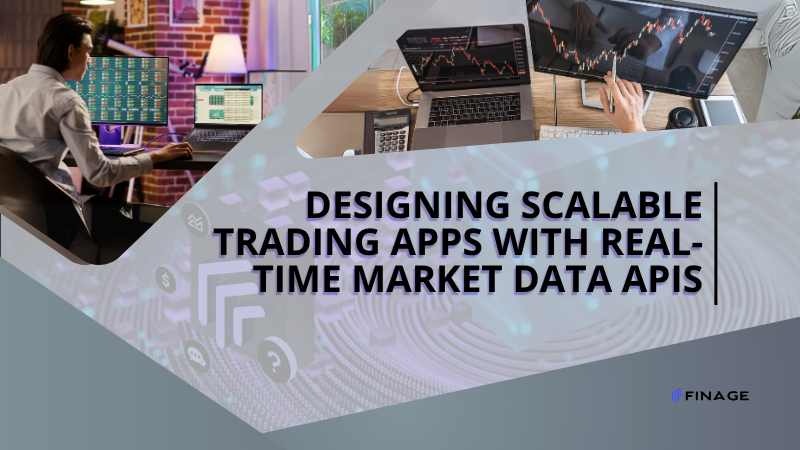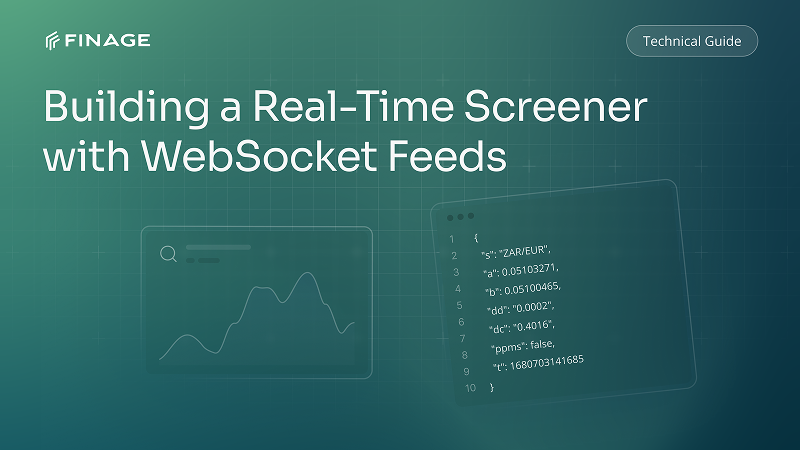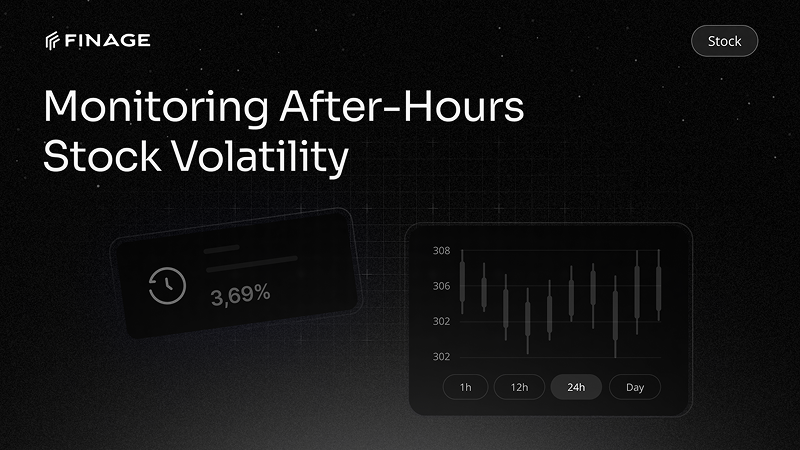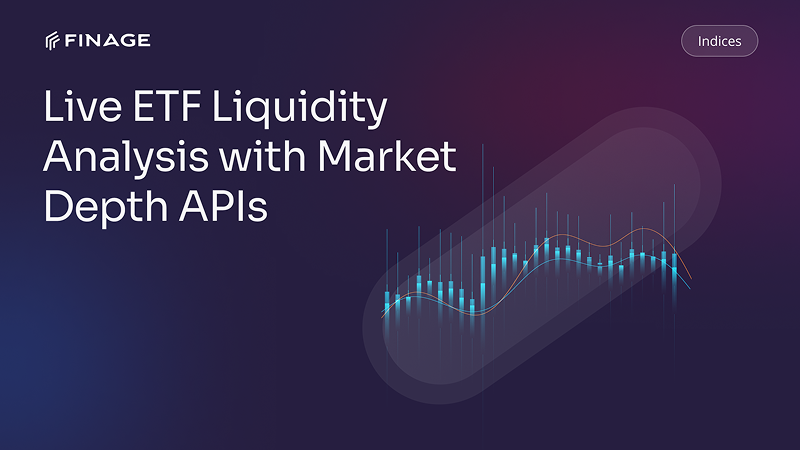Designing Scalable Trading Apps with Real-Time Market Data APIs
13 min read • June 11, 2025

Introduction
Introduction
Modern trading applications demand more than just fast execution — they require real-time data, flexible architecture, and rock-solid scalability. Whether you’re building a lightweight retail trading app or a complex institutional platform, your infrastructure must handle high-throughput data streams, thousands of concurrent users, and seamless updates — all while remaining responsive and reliable.
Real-time market data APIs are the backbone of these applications. But integrating them into a performant trading system isn’t just about fetching quotes — it’s about designing for latency, resilience, and horizontal scaling.
In this blog, we’ll explore how developers and fintech engineers can architect scalable trading platforms using real-time data APIs, with examples from Finage’s REST and WebSocket systems.
Table of Contents
- The Core Building Blocks of a Scalable Trading App
- Why Real-Time Market Data is Essential for Scalability
- REST vs WebSocket APIs: Choosing the Right Data Channel
- Key Architectural Patterns for Real-Time Trading Systems
- Caching, Throttling, and Rate Limits in High-Volume Environments
- Scaling Strategies: Horizontal, Vertical, and Event-Driven Models
- Example: Using Finage APIs in a Scalable Trading Stack
- Monitoring & Failsafes: Designing for Reliability
- Final Thoughts: Building the Future of Real-Time Trading with Finage
1. The Core Building Blocks of a Scalable Trading App
At the heart of every high-performance trading platform are several critical components working in sync. If even one part is under-optimized, the entire app can become slow, unreliable, or worse — unusable during market spikes.
Here’s what makes up a truly scalable trading system:
Real-Time Market Data Feed
Without a reliable source of live pricing, nothing else works. This feed powers:
- Price charts (candlesticks, depth, ticks)
- Order book updates
- Trade execution logic
- Portfolio tracking and PnL (Profit & Loss) calculations
A scalable app needs a low-latency API that pushes frequent updates without bottlenecks. Finage provides this via WebSocket streams and REST endpoints across stocks, forex, crypto, and more.
Order Management System (OMS)
This component handles:
- Order placement (market, limit, stop, etc.)
- Order modification/cancellation
- Status tracking and execution feedback
Your OMS should be modular, asynchronous, and capable of queueing and retrying operations under load.
Trade Execution Engine
Tightly integrated with your OMS and market data feed, the execution engine must:
- React to price triggers instantly
- Maintain risk controls (limits, margin checks, etc.)
- Scale with order volume, even during volatility
It often works alongside automated strategy modules (for algo or rules-based trading).
User Interface (UI) or Frontend
This is where real-time responsiveness truly shines. The frontend should:
- Update instantly on price moves and order book changes
- Provide seamless UX during peak load
- Render charts and analytics with minimal delay
You’ll need a frontend framework that supports WebSocket integration and an architecture that avoids blocking calls.
Back-End Infrastructure and Databases
Scalable systems rely on:
- Message queues (Kafka, RabbitMQ, etc.)
- NoSQL or time-series databases (e.g., MongoDB, InfluxDB)
- Stateless API services
- Horizontal scaling via containers or serverless models
Your database layer should be optimized for fast writes and high-frequency reads — especially for time-sensitive data like OHLCV or tick updates.
2. Why Real-Time Market Data is Essential for Scalability
Real-time market data is more than just a feature — it’s the lifeblood of any trading app. Without timely and accurate data, everything from user interfaces to trading algorithms and compliance reporting starts to break down.
But what does “real-time” truly mean in the context of scalable systems?
Real-Time Data Enables High-Frequency Trading
In fast-moving markets, especially crypto and FX, price changes happen in milliseconds. Traders — human or algorithmic — rely on these updates to:
- React to market volatility
- Execute arbitrage opportunities
- Trigger stop-loss or limit orders
- Rebalance portfolios or hedge exposure
Delays or inconsistencies in price feeds can lead to slippage, loss, or missed trades.
Scaling Requires Precision at Every Layer
In a scalable architecture, you’ll often have:
- Dozens of microservices
- Thousands of concurrent API requests
- Data pipelines running 24/7
- Clients from multiple regions
Real-time data ensures every component is synchronized and consistent. Whether you’re streaming a chart or executing trades from different geographies, your platform must reflect the latest possible market state at all times.
User Experience Depends on Instant Feedback
Users expect immediate updates:
- Live price changes on charts
- Instant order confirmations or rejections
- Real-time balance and margin updates
- Dynamic PnL calculations
Real-time APIs via WebSocket reduce latency and server load while keeping the frontend in sync with reality, which is critical for customer trust and retention.
Compliance and Auditing
When trades happen, regulators and institutions want:
- Exact timestamps
- Accurate quote-at-time-of-order
- Market context at the time of execution
Only live data streams and well-logged API responses can provide this kind of auditable trail.
3. REST vs WebSocket APIs: Choosing the Right Data Channel
At the heart of any scalable trading app lies a critical decision: how will you fetch and stream market data?
Both REST and WebSocket APIs have their roles — but the wrong choice can either bottleneck your system or overcomplicate your infrastructure. Here's how to evaluate both.
REST APIs — Ideal for Simplicity and On-Demand Requests
REST (Representational State Transfer) is stateless and easy to implement. It’s best suited for:
- Loading charts on demand
- Fetching order history or account balances
- Periodic polling of prices for low-frequency use cases
Advantages:
- Simple to integrate with any backend or frontend framework
- Easier to debug and cache
- Well-supported across cloud and edge services
Limitations:
- Higher latency due to polling intervals
- Poor choice for real-time dashboards or HFT systems
- Can spike your API usage and rate limits under load
WebSocket APIs — Essential for Real-Time Streaming
WebSockets enable persistent, two-way communication between your client and the server. This makes them perfect for:
– Live price updates (tick-by-tick)
- Real-time order book visualization
- Trading bots and algo systems
- Updating PnL and portfolio metrics instantly
Advantages:
- Push-based = lower latency
- Scales well with concurrent connections
- Keeps user interfaces responsive
- Reduces unnecessary server load vs REST polling
Limitations:
- Requires a more complex architecture
- Needs error handling for reconnects, throttling, or data bursts
- Slightly steeper learning curve for frontend engineers
Why Finage Offers Both
Finage gives developers the flexibility to:
- Use REST APIs for historical data, one-off conversions, or dashboard queries
- Use WebSocket APIs for low-latency price streaming across stocks, forex, crypto, indices, and more
This hybrid approach allows you to optimize for scale, latency, and simplicity, depending on your app’s use case.
4. Key Architectural Patterns for Real-Time Trading Systems
Scalability doesn’t just come from choosing the right API protocol. It’s the result of designing your entire architecture to handle rapid growth, bursty data, and concurrent users — without sacrificing performance.
Here are the architectural patterns that enable resilient, scalable trading apps:
Microservices Architecture
Instead of a monolith, split your app into isolated services such as:
- Market Data Service
- Order Management Service (OMS)
- User Authentication Service
- Notification and Webhook Engine
This separation allows each module to scale independently based on demand. If your app sees a surge in chart updates, only the market data service needs to scale — not the whole stack.
Event-Driven Design with Message Queues
Use queues and pub/sub systems (like Kafka or RabbitMQ) to decouple services. When a trade executes or a new price arrives:
- A message is published to a topic
- Multiple consumers (e.g., PnL engine, notification bot) can react in real time
This model improves fault tolerance and horizontal scalability, making it easier to recover from partial outages.
Stateless APIs with Load Balancing
Ensure that each API service is stateless — no session or memory dependency. This makes it easy to:
- Load balance across multiple servers
- Autoscale in Kubernetes or serverless platforms
- Recover failed nodes without session loss
Session info can be stored in Redis, and rate limits can be managed at the gateway level.
Real-Time Frontend Integration
Your frontend architecture should:
- Use WebSocket clients with reconnect logic and throttling
- Debounce or batch updates to avoid UI overload
- Isolate components (charts, PnL, order books) for async rendering
This avoids laggy dashboards and ensures real-time fidelity even under peak load.
Data Sharding and Replication for High Availability
For back-end data (orders, trades, positions, etc.), consider:
- Sharding based on user, asset class, or timestamp
- Replication for read-heavy systems (e.g., portfolio views, historical charts)
This boosts both read/write speed and resilience.
5. Caching, Throttling, and Rate Limits in High-Volume Environments
As your trading app scales, every millisecond and every request counts. Without proper caching and traffic control, even the most elegant architecture can collapse under pressure. Here’s how to build fast, resilient systems that keep working as demand grows.
Caching Market Data Without Losing Accuracy
Real-time doesn't mean reloading the same data 10,000 times per second. Instead, apply smart caching to reduce API calls and boost frontend speed.
- Cache non-volatile symbols (e.g., stable pairs or ETFs) for 5–30 seconds
- Use Redis or Memcached to store recent quotes and OHLCV values
- Cache at the edge layer (e.g., CDN or reverse proxy) to reduce global latency
Finage supports both REST and WebSocket, allowing you to cache REST responses while using WebSocket for critical updates.
Rate Limiting to Prevent Abuse and API Overload
APIs — especially public or customer-facing — must enforce limits to:
- Avoid abuse
- Protect infrastructure
- Ensure fair usage
Typical controls include:
- IP-based or API key-based rate limiting
- Throttling rules (e.g., 10 requests/sec, burst limit 100)
- Exponential backoff on retries to reduce pressure during spikes
Finage clearly defines request limits and offers scalable plans tailored for trading apps, ensuring performance remains predictable.
Throttling in the UI and Client Code
Even if your backend can handle rapid data streams, your frontend shouldn’t try to render hundreds of updates per second. Apply throttling on:
- Chart redraws (e.g., update every 500ms, not every tick)
- Portfolio PnL updates
- Order book depth refreshes
This keeps the user experience smooth and responsive, even under heavy trading conditions.
Handling Rate Limit Errors Gracefully
When rate limits are exceeded:
- Return structured error codes (e.g., 429 Too Many Requests)
- Include retry-after headers where appropriate
- Log limit breaches for analysis
- In WebSocket mode, gracefully degrade to lower-fidelity data
A well-designed trading app doesn’t just fail fast — it recovers intelligently.
6. Scaling Strategies: Horizontal, Vertical, and Event-Driven Models
Scalability isn’t just about buying bigger servers. It’s about knowing how and when to scale, depending on your app’s architecture, load type, and user behavior. Let’s break down the three main models — and when to use each.
Vertical Scaling (Scale-Up)
This involves adding more CPU, memory, or I/O power to a single server or service.
Use case:
Great for low-latency components like order matching engines or execution logic where every millisecond matters.
Pros:
- Easier to implement
- Good for real-time, high-throughput components
- Low inter-process communication latency
Cons:
- Hardware limits
- Can be expensive at scale
- A single point of failure unless replicated
Horizontal Scaling (Scale-Out)
This means running multiple instances of a service behind a load balancer or API gateway.
Use case:
Best for stateless services like REST APIs, chart rendering, or user dashboards.
Pros:
- Easy to distribute across global regions
- Fault-tolerant and auto-recoverable
- Works well with containers (Docker, Kubernetes)
Cons:
- Requires external state management (e.g., Redis for sessions)
- Needs rate-limit-aware load balancing
- WebSocket sessions can be trickier to distribute
Event-Driven Scaling
This model uses message brokers and event queues to trigger new processes or scale serverless functions in response to demand.
Use case:
Great for apps processing:
- Trade events
- Notifications
- Webhook triggers
- Tick-level data ingestion
Pros:
- No idle infrastructure (scale-on-demand)
- Ideal for microservices and loosely coupled systems
- Resilient under unpredictable spikes
Cons:
- Cold-start latency in serverless environments
- More complex to architect
- Needs observability tooling for queues and consumers
Finage Works with All Models
Thanks to Finage’s:
- Lightweight WebSocket channels
- Cacheable REST endpoints
- Predictable rate limits and regional endpoints
You can design for vertical precision, horizontal growth, or event-based scaling — whichever fits your trading app’s architecture and budget.
7. Example: Using Finage APIs in a Scalable Trading Stack
Let’s imagine you’re building a multi-asset trading platform for stocks, crypto, and forex. Your app needs to serve thousands of users in real time, process hundreds of data points per second, and support custom dashboards, alerts, and execution logic.
You apply throttling to chart updates every 500ms and use Web Workers to offload tick processing. Charts, order books, and watchlists all stay in sync without REST polling.
Trade Execution & Risk Engine
Your execution engine uses real-time price data and Finage’s reliable latency benchmarks to:
- Trigger stop-loss/limit orders
- Enforce margin thresholds
- Run pre-trade validation
Every order uses the latest streamed price from Finage WebSocket, backed by a price snapshot fallback via REST.
Monitoring & Alerting Services
You set up alerts on currency or stock prices using Finage data + your internal logic. When conditions are met:
- A message is pushed to a Kafka topic
- Consumers send push notifications or webhook events
- Logging and audit data is stored for compliance
This event-driven design ensures fast reactions with full traceability.
Scalability Layer
You deploy the full system on Kubernetes:
- Stateless services (REST APIs, frontend) scale horizontally
- WebSocket services are pinned to users via sticky sessions
- Redis is used for session tracking and cache
- Each service monitors its Finage quota to avoid rate limits
The result? A modular, scalable, and globally responsive trading app that can grow with your user base — without rebuilding from scratch.
8. Monitoring & Failsafes: Designing for Reliability
No matter how well you architect your trading platform, things can go wrong — APIs can throttle, data spikes can overload the frontend, and unexpected outages can affect third-party providers. That’s why observability and failsafes are essential for any scalable app.
Here’s how to build systems that recover fast and fail gracefully:
Monitor Your Data Streams in Real Time
Use observability tools (like Prometheus, Datadog, or Grafana) to track:
- API response times and error rates
- WebSocket connection uptime
- Message throughput and lag in queues
- User-side latency and failed data renders
Set alerts on anomalies so you can respond before users notice.
Track and Rotate API Keys
Even with reliable services like Finage, misuse or overuse of your API key can trigger:
- Rate-limiting
- Temporary bans
- Incomplete responses
Build rotation logic into your app to switch keys when limits are near and log usage to forecast traffic patterns.
Fallback Systems for Data Reliability
What if your WebSocket connection drops or a data provider goes down?
Plan for:
- REST fallback logic to retrieve the latest snapshot
- Retry mechanisms with exponential backoff
- Alert banners in the UI to keep users informed (“data may be delayed”)
These steps help preserve trust and transparency, even during disruptions.
Log Every Critical Event
From order placements to system errors, maintain detailed logs that can be:
- Queried for compliance and auditing
- Used in customer support
- Integrated with tools like Sentry or Loggly
A scalable system isn’t just about performance — it’s also about visibility when things don’t work as expected.
Use WebSocket Ping/Pong to Detect Timeouts
Finage WebSocket streams support heartbeat signals. Your client should:
- Respond to ping with pong
- Automatically reconnect if idle time exceeds a threshold
- Log disconnect reasons for investigation
This ensures continuous data flow, which is critical for trading logic and frontend responsiveness.
9. Final Thoughts
Designing scalable trading applications is no longer optional — it’s the foundation of long-term success in modern fintech. Whether you’re building a crypto exchange, a stock trading app, or a multi-asset investment platform, the ability to stream real-time data, scale across users, and recover from spikes or failures will define your user experience and product longevity.
From choosing between REST and WebSocket APIs to building fault-tolerant architecture and implementing caching, throttling, and observability, each decision shapes how your system performs under real-world trading conditions.
That’s where Finage stands out.
With ultra-low latency WebSocket and REST APIs, high-volume support across stocks, forex, crypto, indices, and ETFs, and developer-friendly documentation, Finage empowers your backend with the data it needs to scale — fast, reliably, and globally.
You can get your Real-Time and Historical Market Data with a free API key.
Build with us today!
Claim Your Free API Key Today
Access stock, forex and crypto market data with a free API key—no credit card required.

Stay Informed, Stay Ahead
Finage Blog: Data-Driven Insights & Ideas
Discover company news, announcements, updates, guides and more


